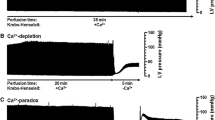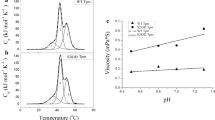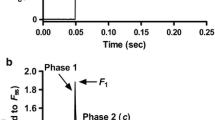Abstract
In this study we tested the hypothesis that reduced myofibrillar ATPase activities in end-stage heart failure are associated with a redistribution of myosin isozymes. Cardiac myofibrils were isolated from left ventricular free wall from normal human hearts and hearts at end-stage heart failure caused by coronary artery diseases, cardiomyopathy or immunological rejection. The hearts had been excised in preparation for a heart transplant. Myofibrillar Ca2−-dependent Mg-ATPase and myosin Ca−- and K−EDTA-ATPase activities were compared. Possible changes in myosin isozyme distribution in the diseased heart were investigated using polyacrylamide gel electrophoresis of native myosin in the presence of pyrophosphate. Significant reduction in myofibrillar Ca2+-dependent Mg-ATPase with no changes in the sensitivity of the myofibrils to Ca+ was observed in heart with coronary artery diseases (25.2 to 27.1% at pCa 5.83 to pCa 5.05), cardiomyopathy (21.1 to 25.5% at pCa 5.41 to pCa 5.05), and in the immunologically rejected heart (18.4 to 22.8% at pCa 5.41 to pCa 5.05). Significantly lower myosin Ca2+-ATPase was observed with coronary artery diseases only and myosin K-EDTA activities did not differ in diseased and normal hearts. Polyacrylamide gel electrophoresis of native myosin from the normal and three models of end-stage heart failure revealed two distinct bands in the human left ventricle and one diffuse band in the human right atria. No apparent differences in myosin isoenzyme pattern were observed between the normal and diseased hearts. Further evaluation is needed to clarify the ATPase nature of the two bands.
Similar content being viewed by others
References
Swynghedauw B, Leger JJ, Schwartz K: The myosin isozyme hypothesis in chronic heart overloading. J Mol Cell Cardiol 8: 915–924, 1976
Alpert NR, Muliere NA, Litten RZ: Functional significance of altered myosin adenosine triphosphatase activity in enlarged hearts. Am J Cardiol 44: 947–953, 1979
Schwartz K, Lecarpentier Y, Martin JL, Lompre AM, Mercadier JJ, Swynghedauw B: Myosin isoenzymic distribution correlates with speed of myocardial contraction. J Mol Cell Cardiol 13: 1071–1075, 1981
Alpert NR, Gordon MS: Myofibrillar adenosine triphosphatase activity in congestive heart failure. Am J Physiol 202:940–956, 1962
Hoh JFY, McGrath PA, Hale PT: Electrophoretic analysis of multiple forms of rat cardiac myosin: Effects of hypophysectomy and thyroxin replacement. J Mol Cell Cardiol 10: 1053–1076, 1978
Swynghedauw BK, Schwartz K, Leger JJ: Cardiac myosin. Phylogenic and pathologic changes. Basic Res Cardiol 72: 254–260, 1977
Clark WA Jr, Chizzonite RA, Everett AW, Rabinowitz M, Zak R: Species correlation between cardiac isomyosins. J Biol Chem 257: 5449–5454, 1982
Schier JJ, Adelstein RS: Structural and enzymatic comparisons of human cardiac muscle myosins isolated from infants, adults and patients with hypertrophic cardiomyopathy. J Clin Invest 69: 816–825, 1982
Banerjee SK, Wiener J: Effects of aging on atrial and ventricular human myosin. Basic Res Cardiol 78: 685–694, 1983
Mercadier JJ, Bouveret P, Gorza L, Schiaffino S, Clark WA, Zak R, Swynghedauw B, Schwartz K: Myosin isoenzyme in normal and hypertrophied human ventricular myocardium. Circ Res 53: 52–62, 1983
Gorza L, Mercadier JJ, Schwartz K, Thornell LE, Sartore S, Schiaffino S: Myosin types in the human heart: An immunofluorescence study of normal and hypertrophied atrial and ventricular myocardium. Circ Res 54: 694–702, 1984
Takeda N, Rupp H, Fenchel G, Hoffmeister HE, Jacob R: Relationship between the myofibrillar ATPase activity of human biopsy material and hemodynamic parameters. Jpn Heart J 26: 909–922, 1985
Pagani ED, Alousi AA, Grant AM, Older TM, Dziuban SW, Allen PD: Changes in myofibrillar content and Mg ATPase activity in ventricular tissues from patients with heart failure caused by coronary artery disease, cardiomyopathy or mitral valve insufficiency. Circ Res 63: 380–385, 1988
Solaro RJ, Pang D, Briggs FN: The purification of cardiac myofibrils with Triton X-100. Biochem Biophys Acta 245: 259–262, 1971
Lowry DH, Rosenbrough NI, Farr AL, Randall RJ: Protein measurement with Folin phenol reagent. J Biol Chem 193: 165–175, 1951
Fabiato A, Fabiato A: Calculator programs for computing the composition of the solutions containing multiple metals and ligands used for skin cells. J Physiol (Paris) 75: 463–505, 1979
Moiseseu DG, Thieleczek R: Calcium and strontium concentration changes within skinned muscle preparations following change in the external bathing solution. J Physiol 275: 242–262, 1978
King EJ: Colorimetric determination of phosphorus. Biochem J 26: 292–297, 1938
Martin AF, Pagani ED, Solaro RJ: Thyroxin-induced redistribution of isozymes of rabbit ventricular myosin. Circ Res 50: 117–124, 1982
Laemmli UK: Cleavage of structural proteins during the assembly of the head of bacteriophage T4. Nature (Lond.) 227: 680–685, 1970
Scheuer J, Bhan AK: Cardiac contractile proteins. Adenosine triphosphate activity and physiological function. Circ Res 45: 1–11, 1979
Gordon MS, Brown AL: Myofibrillar adenosine triphosphatase activity of human heart tissue in congestive failure: Effects of ouabain and calcium. Circ Res 18: 534–542, 1966
Peters TD, Wells G, Oakley CM, Brooksby IAB, Jenkins BS, Webb-Peploe MM, Coltart DJ: Enzymatic analysis of endomyocardial biopsy specimens from patients with cardiomyopathies. Br Heart J 39: 1333–1339, 1977
Leclerq JF, Swynghedauw B: Myofibrillar ATPase, DNA and hydroxyproline content of human hypertrophied heart. Ear J Clin Invest 6: 27–33, 1976
Swynghedauw B: Developmental and functional adaptation of contractile proteins in cardiac and skeletal muscles. Physiol Rev 66: 710–762, 1986
Bhan AK, Scheuer J: Effect of physical training on cardiac myosin ATPase activity. Am J Physiol 228: 1178–1182, 1977
Berson G, Swynghedauw B: Cardiac myofibrillar ATPase and electrophoretic pattern in experimental heart failure produced by a two-step mechanical overloading in the rat. Cardiovasc Res 7: 464–469, 1973
Lompre AM, Schwartz K, D'Albis A, LaCombe G, Thiem NV, Swynghedauw B: Myosin isozyme redistribution in chronic heart overload. Nature Lond 282: 105–107, 1979
Alpert NR, Mulieri LA: Increased myothermal economy of isometric force generation in compensated cardiac hypertrophy induced by pulmonary artery constriction in the rabbit. Circ Res 50: 491–500, 1982
Litten RZ, Martin BJ, Low RB, Alpert NR: Altered myosin isozyme patterns from pressure-overloaded and thyro-toxic hyperthropied rabbit hearts. Circ Res 50: 856–864, 1982
Bugaisky LB, Siegel E, Whalen RG: Myosin isozyme changes in the heart following constriction of the ascending aorta of a 25-day old rat. FEBS Lett 161: 230–234, 1983
Cummins P, Lambert SJ: Myosin transitions in the bovine and human heart. A developmental and anatomical study of heavy and light chain sub-units in the atrium and ventricle. Circ Res 58: 846–858, 1986
Buttrick PM, Malhotra A, Brodman R, McDermott L, Lain L: Myosin isoenzyme distribution in overloaded human atrial tissue. Circulation 74: 477–483, 1986
Bouvagnet P, Neveu S, Montoya M, Leger JJ: Developmental changes in human cardiac isomyosin distribution. An immunohistochemical study using monoclonal antibodies. Circ Res 61: 329–336, 1987
Hoh JFY, McGrath PA, White RI: Electrophoretic analysis of multiple forms of myosin in fast-twitch and slowtwitch muscles of the chick. Biochem J 157: 87–95, 1976
Cummins P: Myosin light chain isoenzyme transitions in the developing and adult human heart. J Mol Cell Cardiol 15(Suppl 2): 65, 1983
Sréter FA, Gregely J, Salmons S, Romanul F: Synthesis by fast muscle of myosin light chains characteristic of slow muscle in response to long-term stimulation. Nature Lond 241:17–18, 1973
Price KM, Littler WA, Cummins P: Human atrial and ventricular myosin light-chain subunits in adult and during development. Biochem J 191: 571–580, 1980
Author information
Authors and Affiliations
Rights and permissions
About this article
Cite this article
Alousi, A.A., Grant, A.M., Etzler, J.R. et al. Reduced cardiac myofibrillar Mg-ATPase activity without changes in myosin isozymes in patients with end-stage heart failure. Mol Cell Biochem 96, 79–88 (1990). https://doi.org/10.1007/BF00228455
Received:
Accepted:
Issue Date:
DOI: https://doi.org/10.1007/BF00228455




